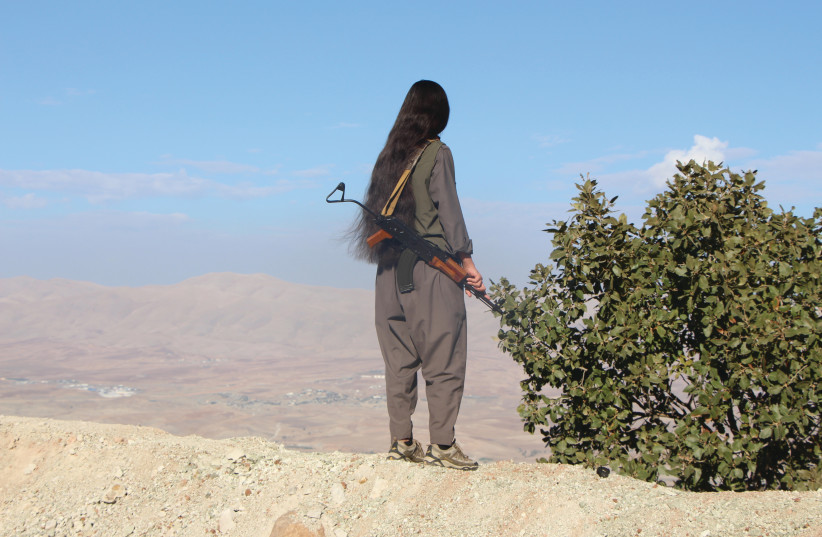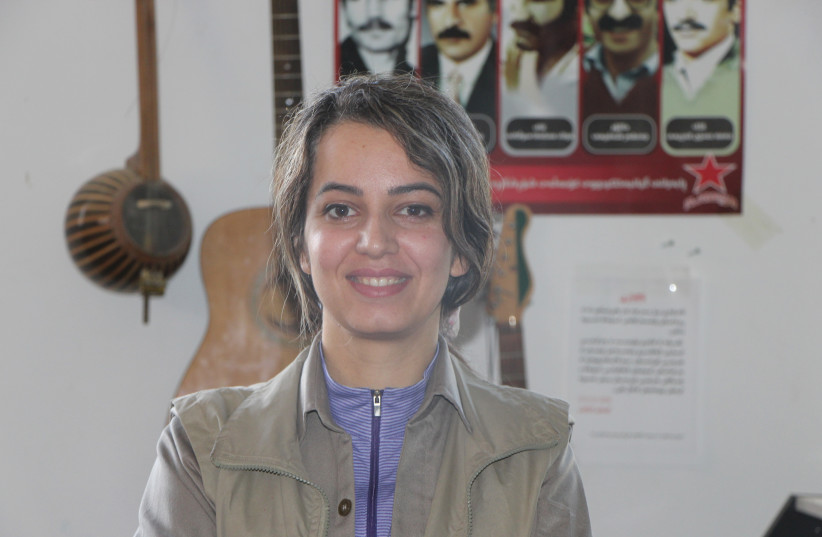by Jonathan Spyer
Kawthar Fatahi, 33, a former teacher from in Iran’s Western Azerbaijan Province, is now a leading activist and organizer for the Iranian Kurdish Komala Party.
 |
A KURDISH Komala fighter looks toward the Iranian border.
(photo credit: JONATHAN SPYER)
|
‘The problem is not only the hijab. This is a symbol. The Iranian regime is intent on controlling how women live, And women are saying, ‘I am human and I have a right to live.’ This time it’s different.”
Kawthar Fatahi, 33, a former teacher from Bukan in Iran’s Western Azerbaijan Province, is now a leading activist and organizer for the Iranian Kurdish Komala Party. We are sitting in her office at the movement’s HQ in Zergwez, Sulaymaniyah Province, northern Iraq, about 50 km. from the Iraq-Iran border. The base was the target of an Iranian drone and missile attack on September 28.
“I thought it was a motorcycle, at first” she tells me. “A horrible, weak, buzzing sound. But it was a suicide drone. You could see it in the sky but you didn’t know where it was going to land.”
The countryside near the Iraq-Iran border is green, verdant and beautiful, in contrast to the desert landscapes a little further west. But two days after our conversation, the base will be targeted again. Fatahi’s office is located in one of the buildings struck by the drones.
In quiet and measured tones, she describes the unexpected outbreak of the uprising that followed calls by Iranian Kurdish organizations, including her own, for protests following the September 16 killing of Mahsa Jina Amini for improper wearing of her compulsory hijab.

“Initially I wasn’t too optimistic. I thought it might be limited to Kurdistan. But now I think it’s different,’” she says. “Nobody thought it would be this big, because a week before in Mariwan, another girl was killed and there were protests – but only in Mariwan. No one else supported them. Then the Kurdish parties called a strike, which was completely successful. So they called the protests. ‘Jin, jiyan, azadi.’ [‘Women, life, freedom’ – a main slogan of the uprising]. And then a few days later, we heard this Kurdish slogan in Tehran.”
SHE IS concerned, nevertheless, at the limited base of support for the revolt.
Mostly young people are protesting
“It remains only Generation Z, 15-25 year olds. There is a need for older people to come into the protests. Everyone decided that they don’t want the regime. But people are scared.” The absence of a clear leadership, much remarked upon in Western analyses of the uprising, is an issue, too.
“It remains only Generation Z, 15-25 year olds. There is a need for older people to come into the protests. Everyone decided that they don’t want the regime. But people are scared.”
Kawthar Fatahi
“Who are the alternative to the regime? It’s still not obvious.... People in Iran are a little afraid of charisma because this is how Khomeini was. They saw his face in the moon, you know? They insist that they don’t need a charismatic leader, that we will not be deceived again. We need a system, they say. A democratic system.
“Some among the Turks [i.e., Azeri Iranians] and the Persians believe in the king, the shah. But even they don’t want him to be king, but that he should take power, a temporary government. And then a referendum. They aren’t frightened that something could be worse than the current regime because nothing could be worse than the current regime.”
The base at Zergwez is host to young men and women who have taken part in the current uprising, and who had to hurriedly leave Iran after the authorities sought to apprehend them. Fatahi herself left Iran for similar reasons some years before the current events. After becoming involved in ‘the social movement, the green movement,’ she was summoned by the Islamic Revolutionary Guard Corps (IRGC) for interrogation, and with the help of the Komala organization fled across the Zagros Mountains to Iraqi Kurdistan.
“When you grow up in Iran, as a woman, and especially as a Kurdish woman, you notice that things are not normal, that you have no place,” she tells me. “So you think about it. Why don’t I have basic rights? We have to wear a hijab from the first days. And step by step you start to think that you’re nothing. How to walk, how to sit, how to eat. It was forbidden for women to eat in the street.”
Komala itself, along with two other Iranian Kurdish movements – the Kurdish Democratic Party of Iran (PDKI) and the Kurdish Freedom Party (PAK) – have been the targets of Iranian missile and drone attacks on three occasions since the outbreak of the uprising in mid-September. A total of 21 people have been killed in these attacks.
Iranian regime media maintains a constant drumbeat of accusations, according to which these organizations are smuggling weaponry across the border to the protesters, and seeking to foment an armed insurgency. Tasnim, for example, a channel associated with the IRGC, reported on November 22 that the armed strikes on the ‘‘Iraqi-based Komala and Democrat terrorist groups came after illegal entry by these groups’ armed teams into the Iranian border cities.”
Kawthar Fatahi and other officials of Komala, PDKI and PAK interviewed by The Jerusalem Post in Iraqi Kurdistan in mid-November dismissed these accusations. It is clear from these interviews that the Kurdish organizations are not leading the current protests, nor do they claim to be doing so. They are, however, involved in activities intended to assist the uprising.
“We have ‘illegal hospitals,’” says Fatahi. “We pay doctors to bring aid to wounded people. We pay the families of wounded people. We assist the movement a lot, but not via armed action.”
ALL THREE of these movements have light weaponry, including machine guns and rocket-propelled grenades (RPGs), as this author witnessed on their bases. The demonstrators inside Iran, meanwhile, are being killed daily. More than 450 people have now died. The organizations are faced with a dilemma. Why not use the available weaponry in order to defend the protesters? And if not now, when? so to speak. I put this question to Fatahi.
“People do call on us to come inside, yes. But we think it’s not yet the time,” she replies. “The regime creates fake scenarios, saying that people from Komala come in with bombs and so on, supported by the US and Israel. We now have four fighters in jail who’ve been forced to say, ‘We’re from Komala, we trained with Israel to come and make explosions.’ But it’s all fake.
“The revolution in 1979 took one year. We need the big cities. We need Tehran. It’s not yet the time. We shouldn’t give the regime excuses. We should go step by step.”
The demonstrations are still continuing, and regime tactics are producing violence in response. A number of IRGC personnel have been killed by the protesters in both Kurdistan and Sistan and Baluchestan Province. The airstrikes on Iranian Kurdish positions across the border are accompanied by increasing use of live ammunition against the protesters. In Iranian Kurdistan this week, another of the periodic general strikes took place, and was widely observed.
Kawthar Fatahi, from her office in Zergwez, next to where the drone struck, is cautiously optimistic.
“The demonstrations need to be continuous. The Iranian regime is very weak now. I know many people who were senior in the regime, in the IRGC, and who have stopped working with them. If the demonstrations continue, and larger numbers come to the revolution, and the strikes continue and spread, I think that step by step, the regime will begin to lose control. I think it’s going to happen.”
Jonathan Spyer
Source: https://www.jpost.com/middle-east/article-724421
No comments:
Post a Comment